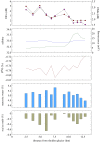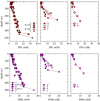Evidences of strong sources of DFe and DMn in Ryder Bay, Western Antarctic Peninsula
- PMID: 29760115
- PMCID: PMC5954471
- DOI: 10.1098/rsta.2017.0172
Evidences of strong sources of DFe and DMn in Ryder Bay, Western Antarctic Peninsula
Abstract
The spatial distribution, biogeochemical cycling and external sources of dissolved iron and dissolved manganese (DFe and DMn) were investigated in Ryder Bay, a small coastal embayment of the West Antarctic Peninsula, during Austral summer (2013 and 2014). Dissolved concentrations were measured throughout the water column at 11 stations within Ryder Bay. The concentration ranges of DFe and DMn were large, between 0.58 and 32.7 nM, and between 0.18 and 26.2 nM, respectively, exhibiting strong gradients from the surface to the bottom. Surface concentrations of DFe and DMn were higher than concentrations reported for the Southern Ocean and coastal Antarctic waters, and extremely high concentrations were detected in deep water. Glacial meltwater and shallow sediments are likely to be the main sources of DFe and DMn in the euphotic zone, while lateral advection associated with local sediment resuspension and vertical mixing are significant sources for intermediate and deep waters. During summer, vertical mixing of intermediate and deep waters and sediment resuspension occurring from Marguerite Trough to Ryder Bay are thought to be amplified by a series of overflows at the sills, enhancing the input of Fe and Mn from bottom sediment and increasing their concentrations up to the euphotic layer.This article is part of the theme issue 'The marine system of the West Antarctic Peninsula: status and strategy for progress in a region of rapid change'.
Keywords: GEOTRACES; Rothera; Western Antarctic Peninsula; iron; manganese; trace metals.
© 2018 The Author(s).
Conflict of interest statement
We declare we have no competing interests.
Figures







Similar articles
-
A 'shallow bathtub ring' of local sedimentary iron input maintains the Palmer Deep biological hotspot on the West Antarctic Peninsula shelf.Philos Trans A Math Phys Eng Sci. 2018 Jun 28;376(2122):20170171. doi: 10.1098/rsta.2017.0171. Philos Trans A Math Phys Eng Sci. 2018. PMID: 29760114 Free PMC article.
-
[Vertical Distribution Characteristics of Fe and Mn in Subtropical Reservoirs During Summer].Huan Jing Ke Xue. 2017 Nov 8;38(11):4546-4552. doi: 10.13227/j.hjkx.201704233. Huan Jing Ke Xue. 2017. PMID: 29965397 Chinese.
-
Seasonal Dynamics of Dissolved Iron on the Antarctic Continental Shelf: Late-Fall Observations From the Terra Nova Bay and Ross Ice Shelf Polynyas.J Geophys Res Oceans. 2022 Oct;127(10):e2022JC018999. doi: 10.1029/2022JC018999. Epub 2022 Oct 17. J Geophys Res Oceans. 2022. PMID: 36590600 Free PMC article.
-
Trace metals in Antarctica related to climate change and increasing human impact.Rev Environ Contam Toxicol. 2000;166:129-73. Rev Environ Contam Toxicol. 2000. PMID: 10868078 Review.
-
Shelf-ocean exchange and hydrography west of the Antarctic Peninsula: a review.Philos Trans A Math Phys Eng Sci. 2018 Jun 28;376(2122):20170164. doi: 10.1098/rsta.2017.0164. Philos Trans A Math Phys Eng Sci. 2018. PMID: 29760109 Free PMC article. Review.
Cited by
-
The marine system of the West Antarctic Peninsula: status and strategy for progress.Philos Trans A Math Phys Eng Sci. 2018 Jun 28;376(2122):20170179. doi: 10.1098/rsta.2017.0179. Philos Trans A Math Phys Eng Sci. 2018. PMID: 29760121 Free PMC article. No abstract available.
-
A 'shallow bathtub ring' of local sedimentary iron input maintains the Palmer Deep biological hotspot on the West Antarctic Peninsula shelf.Philos Trans A Math Phys Eng Sci. 2018 Jun 28;376(2122):20170171. doi: 10.1098/rsta.2017.0171. Philos Trans A Math Phys Eng Sci. 2018. PMID: 29760114 Free PMC article.
-
The influence of Arctic Fe and Atlantic fixed N on summertime primary production in Fram Strait, North Greenland Sea.Sci Rep. 2020 Sep 17;10(1):15230. doi: 10.1038/s41598-020-72100-9. Sci Rep. 2020. PMID: 32943713 Free PMC article.
-
The influence of glacial melt and retreat on the nutritional condition of the bivalve Nuculana inaequisculpta (Protobranchia: Nuculanidae) in the West Antarctic Peninsula.PLoS One. 2020 May 21;15(5):e0233513. doi: 10.1371/journal.pone.0233513. eCollection 2020. PLoS One. 2020. PMID: 32437403 Free PMC article.
References
-
- Bhatia MP, Kujawinski EB, Das SB, Breier CF, Henderson PB, Charette MA. 2013. Greenland meltwater as a significant and potentially bioavailable source of iron to the ocean. Nat. Geo. 6, 274–278. (10.1038/ngeo1746) - DOI
-
- Wehrmann LM, Formolo MJ, Owens JD, Raiswell R, Ferdelman TG, Riedinger N, Lyons TW. 2014. Iron and manganese speciation and cycling in glacially influenced high-latitude fjord sediments (West Spitsbergen, Svalbard): evidence for a benthic recycling-transport mechanism. Geochim. Cosmochim. Acta 141, 628–655. (10.1016/j.gca.2014.06.007) - DOI
LinkOut - more resources
Full Text Sources
Other Literature Sources

